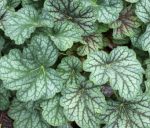 Also called rock geranium, this evergreen, clump-forming, herbaceous perennial is a member of the saxifrage family, Saxifragaceae, that also includes astilbe, bergenia, and tiarella. It is native to the eastern half of the country from Maine south to Georgia and west from Nebraska to Louisiana where it grows in rocky well-drained soil in woodlands as well as open sites. Plants form clumps up to 15″ tall consisting of heart-shaped leaves. The 4-10 long leaves are carried on long petioles and have 5-7 lobes. Young leaves are mottled purple before turning silvery green in summer and red or purplish in the fall. The 1/8- 1/4 ” wide white flowers are bell-shaped and carried in open unbranched panicles on wiry stems 15-20″ long, well above the foliage. Plants like medium moist, well-drained soil in full sun but need shade if temperatures is hot or moisture is lacking. American alumroot is grown primarily for its foliage and some gardeners remove the flower stalks. They are a good choice for a ground cover, rock garden, border, woodland garden, or native plant garden where their handsome foliage can be appreciated. The genus name Heuchera honors Johann Heinrich von Heucher (1677-1747) who was a botanist, physician, and medicinal plant expert at Wittenberg University, Germany. The specific epithet, americana, refers to the geographic habitat of the plant.
Also called rock geranium, this evergreen, clump-forming, herbaceous perennial is a member of the saxifrage family, Saxifragaceae, that also includes astilbe, bergenia, and tiarella. It is native to the eastern half of the country from Maine south to Georgia and west from Nebraska to Louisiana where it grows in rocky well-drained soil in woodlands as well as open sites. Plants form clumps up to 15″ tall consisting of heart-shaped leaves. The 4-10 long leaves are carried on long petioles and have 5-7 lobes. Young leaves are mottled purple before turning silvery green in summer and red or purplish in the fall. The 1/8- 1/4 ” wide white flowers are bell-shaped and carried in open unbranched panicles on wiry stems 15-20″ long, well above the foliage. Plants like medium moist, well-drained soil in full sun but need shade if temperatures is hot or moisture is lacking. American alumroot is grown primarily for its foliage and some gardeners remove the flower stalks. They are a good choice for a ground cover, rock garden, border, woodland garden, or native plant garden where their handsome foliage can be appreciated. The genus name Heuchera honors Johann Heinrich von Heucher (1677-1747) who was a botanist, physician, and medicinal plant expert at Wittenberg University, Germany. The specific epithet, americana, refers to the geographic habitat of the plant.
Type: Herbaceous perennial
Bloom: Tiny, white, bell-shaped flowers in
Size: 18-36″ H x 18″ W
Light:Full sun to part shade; shade needed if temperature is hot or moisture is lacking.
Soil:Fertile, medium moist, well-drained
Hardiness: Zones 4-9
Care: Deadhead to prolong bloom time; apply mulch to avoid heaving in cold climates.
Pests and Diseases: None of significance
Propagation: Division or seed
Companion Plants: Goat’s beard (Aruncus dioicus), woodland phlox (Phlox divaricata), crested iris (Iris cristata)
Outstanding Selections: Dale’s Strain’ (gray-green leaves with silver mottling)